Responses of Baseflow to Ecological Construction and Climate Change in Different Geomorphological Types in The Middle Yellow River, China
Abstract
1. Introduction
2. Data and Methods
2.1. Study Area
2.2. Data Sources
2.3. Methodology
2.3.1. Baseflow Segment Method
2.3.2. Periodic Analysis of Baseflow
2.3.3. Change Point of Baseflow Identification
3. Results
3.1. Baseflow Trend Test on an Annual Scale
3.2. Annual Baseflow Amount Cycle Change
3.3. Change Points in Annual Baseflow Amount
3.4. Baseflow Amount Difference in Different Geomorphic Types
4. Discussion
4.1. Responses of Baseflow to Climate and Vegetation Change
4.2. Responses of Baseflow to the Construction of Check Dams and Terraces
5. Conclusions
Author Contributions
Funding
Acknowledgments
Conflicts of Interest
References
- Lin, X.Y.; Liao, Z.S.; Qian, Y.P.; Su, X.S. Baseflow separation for groundwater study in the Yellow River basin. China. J. Jilin Univ. (Earth Sci. Edition) 2009, 39, 959–967. [Google Scholar]
- Piao, S.L.; Ciais, P.; Huang, Y.; Shen, Z.H.; Peng, S.S.; Li, J.S.; Zhou, L.P.; Liu, H.Y.; Ma, Y.C.; Ding, Y.H.; et al. The impacts of climate change on water resourcesand agriculture in China. Nature. 2010, 467, 43–51. [Google Scholar] [CrossRef] [PubMed]
- Stednick, J.D. Monitoring the effects of timber harvest on annual water yield. J. Hydrol. 1996, 176, 79–95. [Google Scholar] [CrossRef]
- Bronstert, A.; Niehof, D.; Bilrger, G. Effects of climate and land-use change on storm runoff generation: Present knowledge and modeling capabilities. Hydrol. Process. 2002, 16, 509–529. [Google Scholar] [CrossRef]
- Tallaksen, L. A review of baseflow recession analysis. J. Hydrol. 1995, 165, 349–370. [Google Scholar] [CrossRef]
- Mwakalila, J.; Feyen, J.; Wyseure, G. The influence of physical catchment properties on baseflow in semi-arid environments. J. Arid Environ. 2002, 52, 245–258. [Google Scholar] [CrossRef]
- Lacey, G.C.; Grayson, R.B. Relating baseflow to catchment properties in south-eastern Australia. J. Hydrol. 1998, 204, 231–250. [Google Scholar] [CrossRef]
- Santhi, C.; Allen, P.M.; Muttiah, R.S.; Arnold, J.G.; Tuppad, P. Regional estimation of base flow for the conterminous United States by hydrologic landscape regions. J. Hydrol. 2008, 351, 139–153. [Google Scholar] [CrossRef]
- Arnell, N.W. Factors controlling the effects of climate change on river flow regimes in a humid temperate environment. J. Hydrol. 1992, 132, 321–342. [Google Scholar] [CrossRef]
- Schaake, J.C.; Liu, C.Z. Development and application of simple water balance models to understand the relationship between climate and water resources. In New Directions for Surface Water Modeling, Proceedings of the Baltimore Symposium, Baltimore, MD, USA, 2–4 May 1989; IAHS Publication: Wallingford, UK, 1989; pp. 343–352. [Google Scholar]
- Wilby, R.; Greenfield, B.; Glenny, C. A coupled synoptic-hydrological model for climate change impact assessment. J. Hydrol. 1994, 153, 265–290. [Google Scholar] [CrossRef]
- Arnell, N.W. Changing frequency of extreme hydrological events in northern and western Europe. FRIENDS Hydrol. 1989, 187, 237–249. [Google Scholar]
- Gao, Z.L.; Fu, Y.L.; Li, Y.H.; Liu, J.X.; Chen, N.; Zhang, X.P. Trends of streamflow, sediment load and their dynamic relation for the catchments in the middle reaches of the Yellow River over the past five decades. Hydrol. Earth Syst. Sci. 2012, 16, 3219–3231. [Google Scholar] [CrossRef]
- Hu, C.H.; Zhang, X.M. Several key questions in the researches of runoff and sediment changes and trend predictions in the Yellow River. J. Hydraul. Eng. 2018, 49, 1028–1039. [Google Scholar]
- Gu, C.J.; Mu, X.M.; Gao, P.; Zhao, G.J.; Sun, W.Y. Changes in run-off and sediment load in the three parts of the Yellow River basin, in response to climate change and human activities. Hydrol. Process. 2019, 33, 585–601. [Google Scholar] [CrossRef]
- Wang, Y.L.; Wang, W.K.; Qian, Y.P.; Duan, L.; Yang, Z.Y. Change characteristics and driving forces of baseflow of Yellow River basin. J. Nat. Resour. 2008, 23, 479–486. [Google Scholar]
- Yang, Q.N.; Li, Z.B.; Lu, K.X.; Gao, H.D.; Wang, J. Base flow variation characteristics and reason analysis of arid region river: A case study of Wuding River basin. Taiwan Water Conserv. 2019, 66, 67–75. [Google Scholar]
- Lei, Y.N.; Zhang, X.P.; Zhang, J.J.; Liu, E.J. Change trends and driving factors of base flow in Kuye River catchment. Acta Ecol. Sinica 2013, 33, 1559–1568. [Google Scholar]
- Li, B.B.; Li, Z.B.; Hao, Z.Y.; Yang, S.L.; Huang, J.X. Response of vegetation pattern characteristics to sediment yield in Dali River basin. Trans. the Chin. Soc. Agric. Eng. 2017, 33, 171–178. [Google Scholar]
- Valiantzas, J.D. Simplified limited data Penman’s ET0 formulas adapted for humid locations. J. Hydrol. 2015, 524, 701–707. [Google Scholar] [CrossRef]
- Eckhardt, K. A comparison of baseflow indices, which were calculated with seven different baseflow separation methods. J. Hydrol. 2008, 352, 168–173. [Google Scholar] [CrossRef]
- Qin, Y.; Tang, B.; Wang, J. Higher-density dyadic wavelet transform and its application. Mech. Syst. Signal Process. 2010, 24, 823–834. [Google Scholar] [CrossRef]
- Bernaola-Galván, P.; Ivanov, P.C.; Nunes, A.; Luís, A.; Eugene, S.H. Scale Invariance in the Nonstationarity of Human Heart Rate. Phys. Rev. Lett. 2001, 87, 168105. [Google Scholar] [CrossRef] [PubMed]
- Wang, W.S.; Jin, J.L.; Ding, J. Stochastic Hydrology, 3rd ed.; Chinese Water & Power Press: Beijing, China, 2016. [Google Scholar]
- Ren, Z.P.; Ma, Y.Y.; Wang, Y.S.; Xie, M.Y.; Li, P. Runoff changes and attribution analysis in tributaries of different geomorphic regions in Wuding River under ecological construction. Acta Ecol. Sin. 2019, 39, 4309–4318. [Google Scholar]
- Mu, X.M.; Zhang, L.; McVicar, T.R. Estimating the Impact of Conservation Measures on Stream-flow Regime in Catchments of the Loess Plateau, China. Hydrol. Process. 2007, 21, 2124–2134. [Google Scholar]
- Dou, L.; Huang, M.B.; Hong, Y. Statistical Assessment of the Impact of Conservation Measures on Streamflow Responses in a Watershed of the Loess Plateau. Water Resour. Manag. China 2009, 23, 1935–1949. [Google Scholar] [CrossRef]
- Vǒrǒsmarty, C.J.; Green, P.; Salisbury, J. Global water resources: Vulnerability from climate change and population growth. Science 2000, 289, 284–288. [Google Scholar] [CrossRef]
- Swank, W.T.; Crossley, D.A., Jr. Forest Hydrology and Ecology at Coweeta; Springer: New York, NY, USA, 1988. [Google Scholar]
- Jaramillo, F.; Destouni, G. Local flow regulation and irrigation raise global human waterconsumption and footprint. Science 2015, 350, 1248–1251. [Google Scholar] [CrossRef]
- Feng, A.Q.; Li, Y.Z.; Gao, J.B.; Wu, S.H.; Feng, A.X. The determinants of streamflow variability and variation in Three River Source of China: Climate change of ecological restoration? Environ. Earth Sci. 2017, 76, 1–10. [Google Scholar] [CrossRef]
- Guzha, A.C.; Rufino, M.C.; Okoth, S.; Jacobs, S.; Nobrega, R.L.B. Impacts of land use and land cover change on surface runoff, discharge and low flows: Evidence from East Africa. J. Hydrol. Reg. Stud. 2018, 15, 49–67. [Google Scholar] [CrossRef]
- Jin, X.M.; Guo, R.H.; Zhang, Q.; Zhou, Y.X.; Zhang, D.R.; Yang, Z. Response of vegetation pattern to different landform and water-table depth in Hailiutu River basin, Northwestern China. Environ. Earth Sci. 2014, 71, 4889–4898. [Google Scholar] [CrossRef]
- Seeger, M. Uncertainty of factors determining runoff and erosion processes as quantified by rainfall simulations. Catena 2007, 71, 56–67. [Google Scholar] [CrossRef]
- Lotfalian, M.; Parsakhoo, A.; Kavian, A.; Hosseini, S.A. Runoff and sediment concentration of different parts of a road in Hyrcanian forests. Forest Ecosyst. 2013, 15, 144–151. [Google Scholar] [CrossRef]
- Peel, M.C.; Mcmahon, T.A.; Finlayson, B.L. Vegetation impact on mean annual evapotranspiration at a global catchment scale. Water Resour. Res. 2010, 46, 2095–2170. [Google Scholar] [CrossRef]
- Zhang, L.; Dawes, W.R.; Walker, G.R. Response of mean annual evapotranspiration to vegetation change sat catchment scale. Water Resour. Res. 2001, 37, 701–708. [Google Scholar] [CrossRef]
- Xia, L.; Song, X.Y.; Fu, N.; Cui, S.Y.; Li, L.J.; Li, H.Y.; Li, Y.L. Effects of forest litter cover on hydrological response of hillslopes in the Loess Plateau of China. Catena 2019, 181, 1–11. [Google Scholar] [CrossRef]
- Wang, L.X.; Xu, Z.Q. Advances in the Study of Ecohydrological Effects from Vegetation Changes. World Forestry Res. 1998, 6, 15–24. [Google Scholar]
- Mu, X.M.; Xu, X.X.; Wang, W.L. The impact of high-level controlling of soil and water loss on watershed rundff in the Loess Plateau. J. Arid Land Resour. Environ. 1998, 4, 120–127. [Google Scholar]
- Jiang, D.S. Soil Erosion and Control Models in The Loess Plateau; China Water & Power Press: Beijing, China, 1997. [Google Scholar]
- Shao, H.; Baffaut, C.; Gao, J.E. Development and application of algorithms for simulating terraces within SWAT. Trans. ASABE 2013, 56, 1715–1730. [Google Scholar]
- Zhang, X.P.; Zhang, L.; Mu, X.M.; Li, R. The mean annual water balance in the Hekou-Longmen section of the Middle Yellow River: Testing of the regional scale water valance model and its calibration. Acta Geogr. Sin. 2007, 7, 753–763. [Google Scholar]
- Li, J.; Gao, J.E.; Zhang, Y.X.; Shao, H. Effects of terrace on runoff and ecological base flow of Jinghe Watered in Loess Plateau region. Bull. Soil Water Conserv. 2015, 35, 106–116. [Google Scholar]
- Ning, T.T.; Li, Z.; Liu, W.Z. Separating the impacts of climate change and land surface alteration on runoff reduction in the Jing River catchment of China. Catena 2016, 147, 80–86. [Google Scholar] [CrossRef]
- Jiang, C.; Zhang, H.Y.; Wang, X.C.; Feng, Y.Q.; Labzovskii, L. Challenging the land degradation in China’s Loess Plateau: Benefits, limitations, sustainability, and adaptive strategies of soil and water conservation. Ecol. Eng. 2019, 127, 135–150. [Google Scholar] [CrossRef]
- Liu, G.B. Soil conservation and sustainable agriculture on the Loess Plateau: Challenges and prospects. Ambio 1999, 28, 663–668. [Google Scholar]
- Feng, X.M.; Fu, B.J.; Piao, S.L.; Wang, S.; Ciais, P.; Zeng, Z.Z.; Lu, Y.H.; Zeng, Y.; Li, Y.; Jiang, X.H. Revegetation in China’s Loess Plateau is approaching sustainable water resource limits. Nat. Clim. Chang. 2016, 6, 1019–1022. [Google Scholar] [CrossRef]
- Jing, K.; Zheng, F.L. Effects of soil and water conservation on surface water resource on the Loess Plateau. Res. Soil Water Conserv. 2004, 04, 13–14+75. [Google Scholar]
- Yang, D.W.; Shao, W.W.; Yeh Pat, J.-F.; Yang, H.B.; Kanac, S.; Oki, T. Impact of vegetation coverage on regional water balance in the nonhumid regions of China. Water Resour. Res. 2009, 45, 1–13. [Google Scholar] [CrossRef]
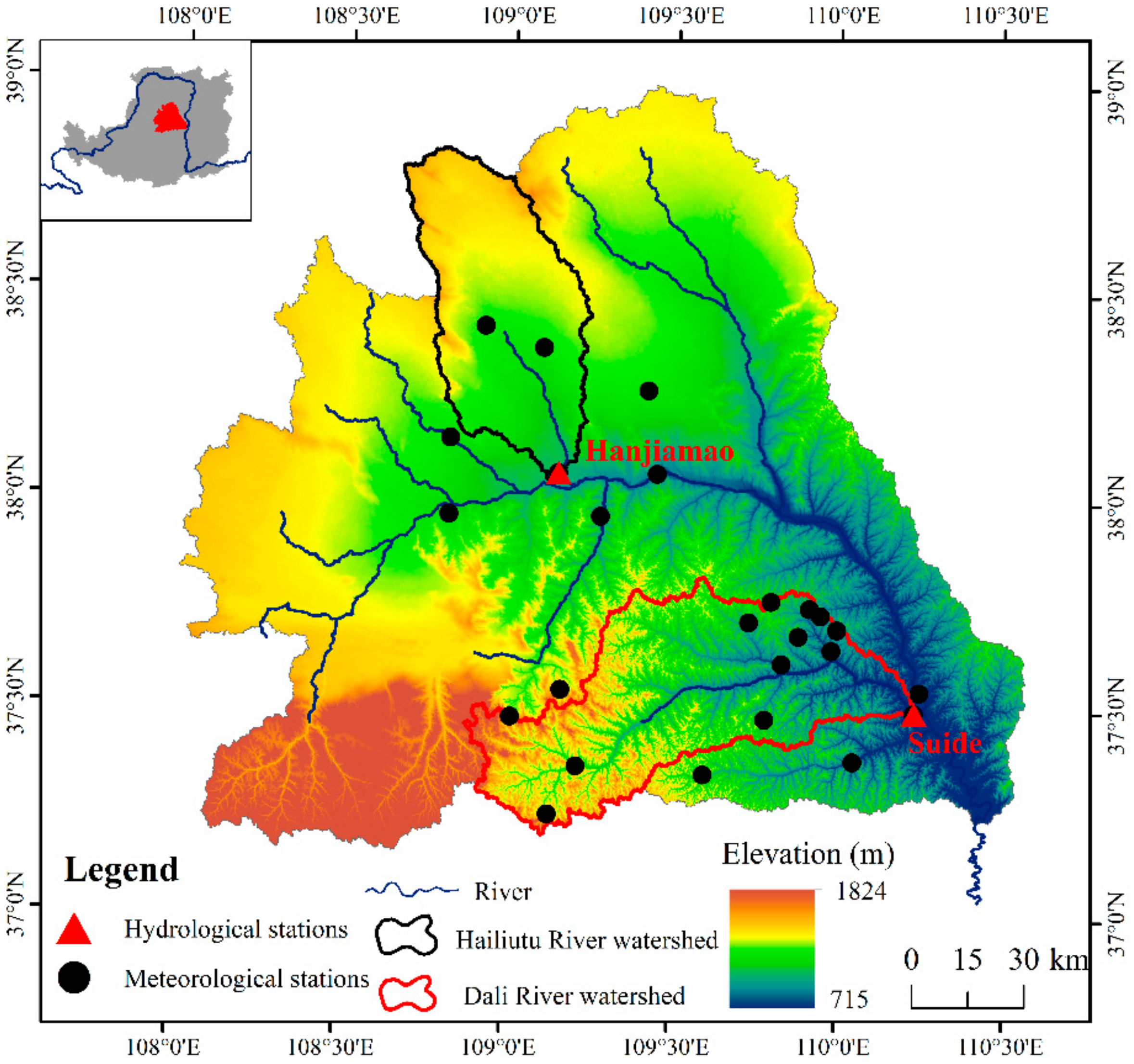
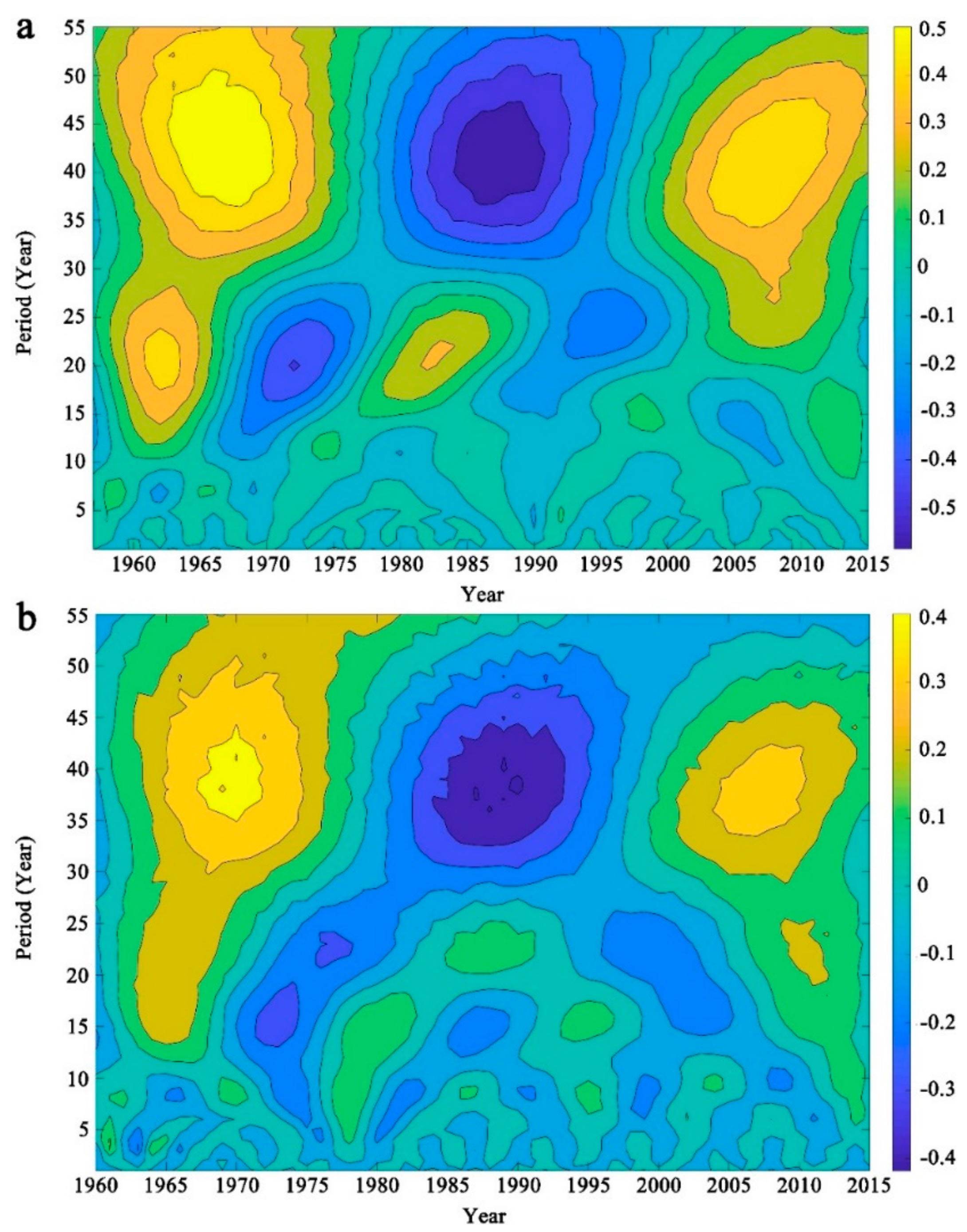
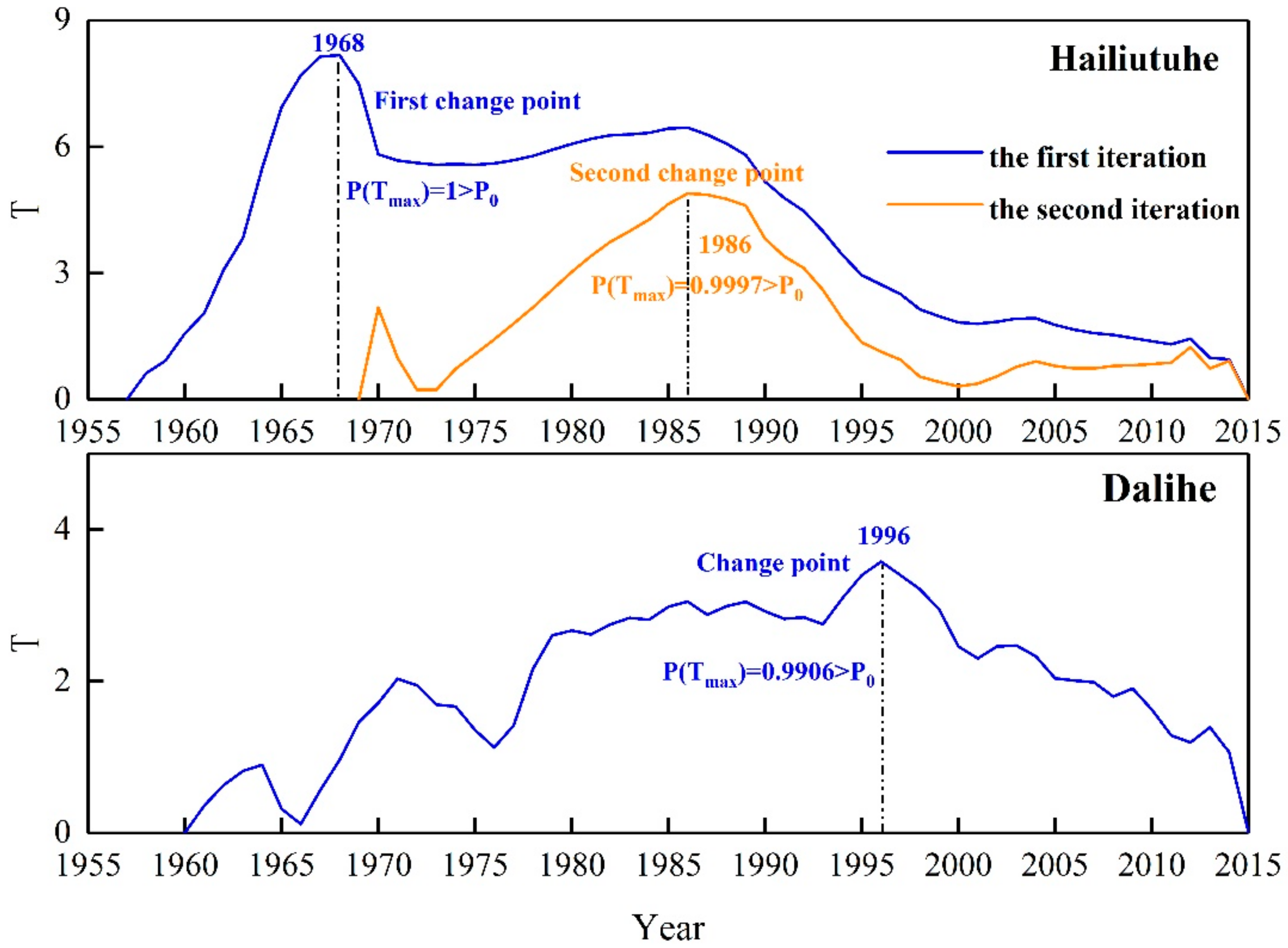
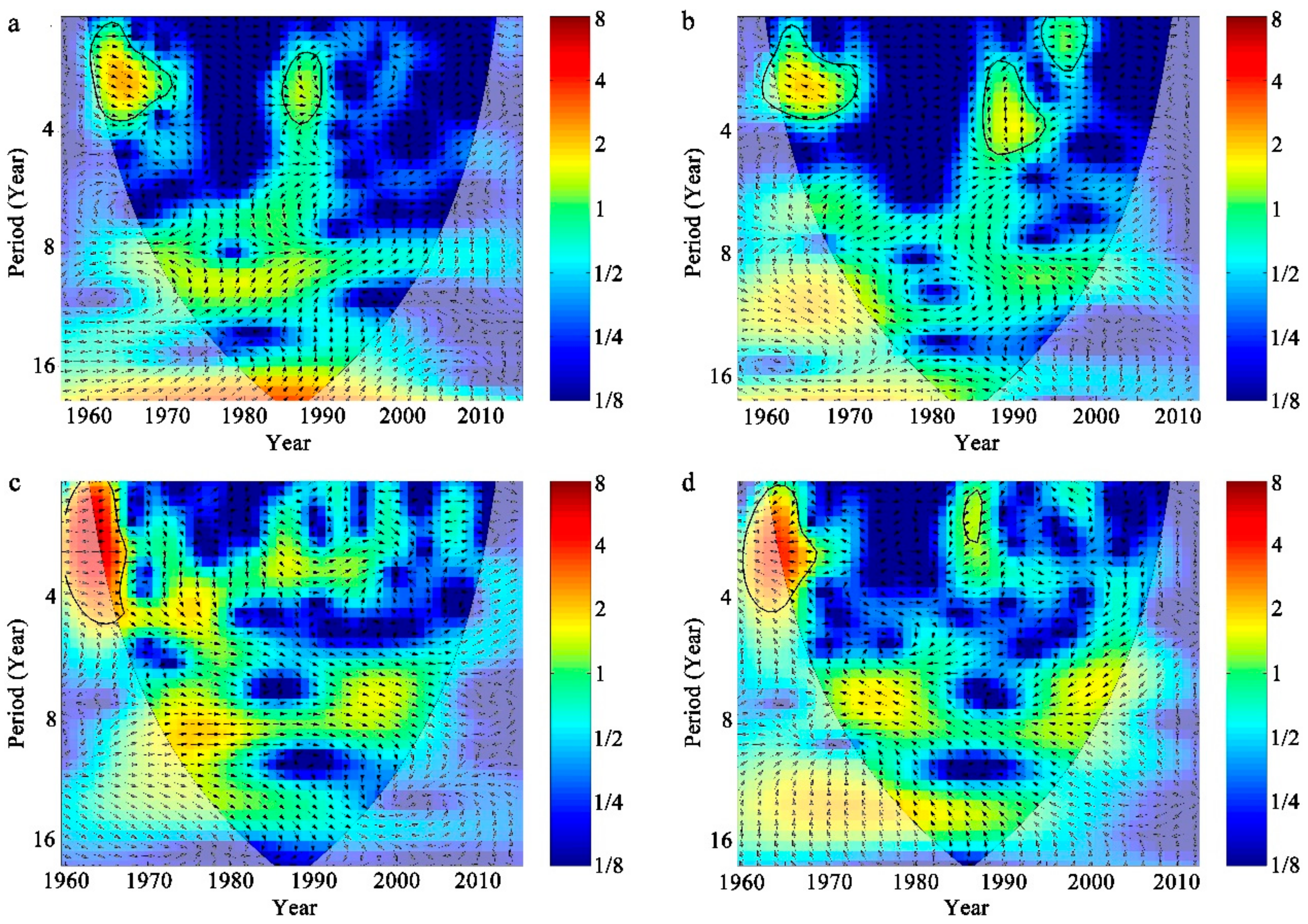
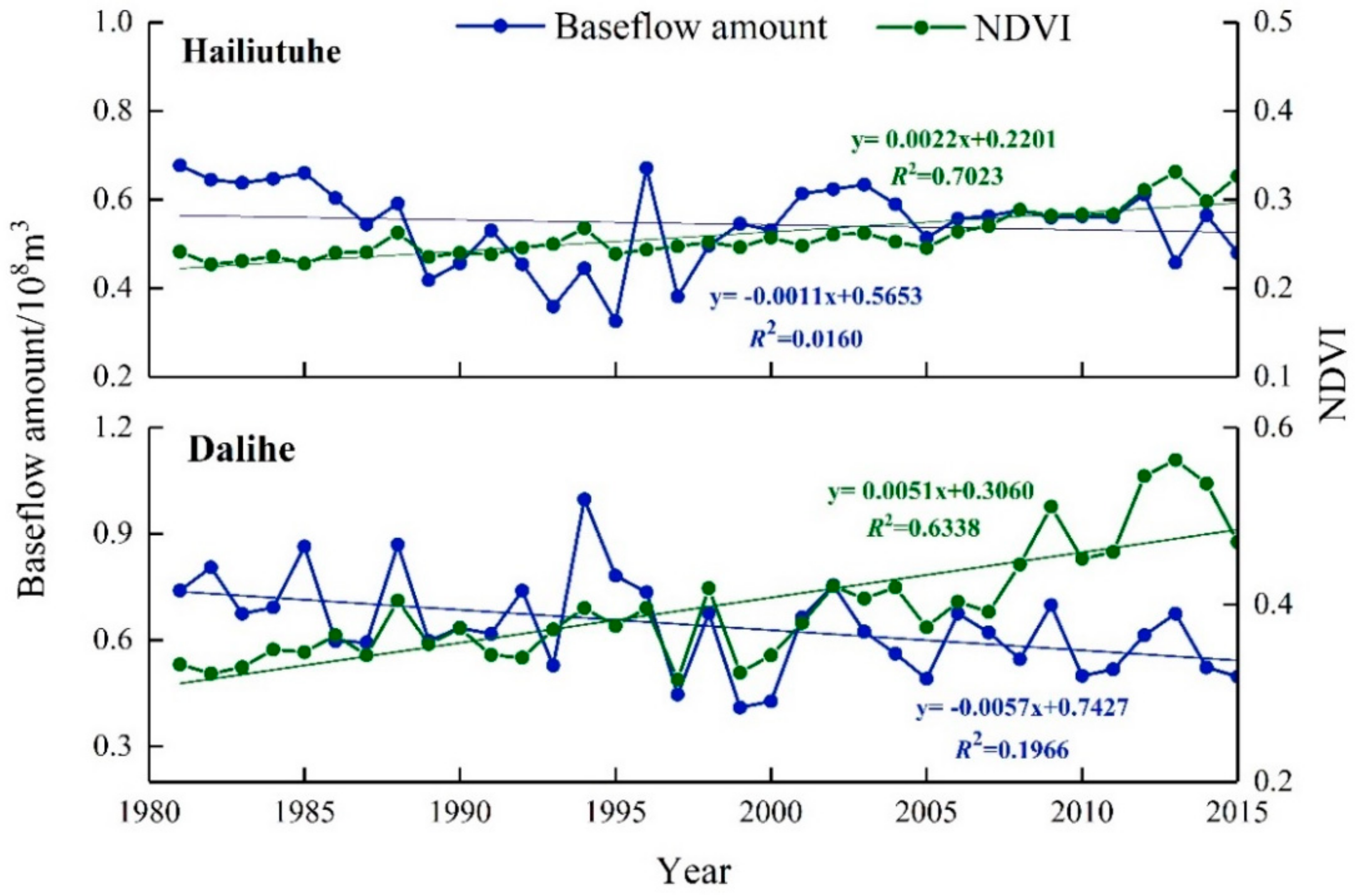
| Statistical Indicators | HLTR | DLR | ||||
|---|---|---|---|---|---|---|
| Annual Streamflow Amount /108 m3 | Annual Baseflow Amount /108 m3 | BFI | Annual Streamflow Amount /108 m3 | Annual Baseflow Amount /108 m3 | BFI | |
| Minimum value | 0.42 | 0.33 | 0.59 | 0.38 | 0.27 | 0.38 |
| Maximum value | 1.61 | 1.15 | 0.80 | 2.62 | 1.15 | 0.72 |
| Average value | 0.83 | 0.62 | 0.75 | 1.33 | 0.69 | 0.55 |
| Variation coefficient | 0.24 | 0.24 | 0.06 | 0.37 | 0.26 | 1.48 |
| Watershed | Period | Baseflow Amount/108 m3 | BFI | ||
|---|---|---|---|---|---|
| Average Value | Variation Coefficient | Average Value | Variation Coefficient | ||
| HLTR | HLT_P1 | 0.85 | 0.15 | 0.77 | 0.04 |
| HLT_P2 | 0.64 | 0.11 | 0.75 | 0.06 | |
| HLT_P3 | 0.52 | 0.16 | 0.75 | 0.07 | |
| DLR | DLH_P1 | 0.78 | 0.30 | 0.70 | 0.10 |
| DLH_P2 | 0.73 | 0.23 | 0.74 | 0.06 | |
| DLH_P3 | 0.58 | 0.18 | 0.73 | 0.09 | |
| Indicators | P2-P1 | P3-P2 | P3-P1 | |||
|---|---|---|---|---|---|---|
| HLTR | DLR | HLTR | DLR | HLTR | DLR | |
| Change amount (108 m3) | −0.22 | −0.05 | −0.12 | −0.15 | −0.33 | −0.20 |
| Change rate (%) | −25.3% | −6.4% | −18.08% | −20.5% | −38.78% | −25.6% |
| HLTR | DLR | ||||
|---|---|---|---|---|---|
| Period | Precipitation | ET0 | Period | Precipitation | ET0 |
| HLTR_P1 | 0.368 ** | 0.008 | DLH_P1 | 0.498 ** | −0.349 |
| HLTR_P2 | 0.464 | 0.168 | DLH_P2 | 0.746 ** | −0.365 |
| HLTR_P3 | 0.062 | −0.337 | DLH_P3 | 0.503 ** | −0.403 |
| 1957–2015 | 0.261 | −0.356 ** | 1960–2015 | 0.552 ** | −0.507 ** |
| Time Series | Trend Test | Correlation | ||
|---|---|---|---|---|
| Silted Storage Capacity | BFI | With Annual Baseflow Amount | With BFI | |
| 1960–1971 | 4.46 *** | −1.17 | 0.294 | −0.440 |
| 1972–1996 | 6.98 *** | −2.27 * | 0.038 | −0.559 ** |
| 1997–2011 | 5.15 *** | 2.94 ** | 0.142 | 0.581 * |
| 1972–2011 | 9.08 *** | 0.56 | −0.373 * | 0.011 |
| 1960–2011 | 10.98 *** | −0.29 | −0.375 ** | −0.168 |
| Time Series | Trend Test | Correlation | ||
|---|---|---|---|---|
| Terraced Area | BFI | With Annual Baseflow Amount | With BFI | |
| 1960–1971 | 4.46 *** | −1.17 | 0.263 | −0.422 |
| 1972–1996 | 6.94 *** | −2.27 * | 0.000 | −0.631 ** |
| 1997–2015 | 4.83 *** | 2.94 ** | 0.154 | 0.611 ** |
| 1972–2015 | 9.21 *** | 0.56 | −0.399 ** | −0.04 |
| 1960–2015 | 10.64 *** | −0.29 | −0.397 ** | −0.19 |
© 2020 by the authors. Licensee MDPI, Basel, Switzerland. This article is an open access article distributed under the terms and conditions of the Creative Commons Attribution (CC BY) license (http://creativecommons.org/licenses/by/4.0/).
Share and Cite
Yang, Q.; Li, Z.; Han, Y.; Gao, H. Responses of Baseflow to Ecological Construction and Climate Change in Different Geomorphological Types in The Middle Yellow River, China. Water 2020, 12, 304. https://doi.org/10.3390/w12010304
Yang Q, Li Z, Han Y, Gao H. Responses of Baseflow to Ecological Construction and Climate Change in Different Geomorphological Types in The Middle Yellow River, China. Water. 2020; 12(1):304. https://doi.org/10.3390/w12010304
Chicago/Turabian StyleYang, Qiannan, Zhanbin Li, Yong Han, and Haidong Gao. 2020. "Responses of Baseflow to Ecological Construction and Climate Change in Different Geomorphological Types in The Middle Yellow River, China" Water 12, no. 1: 304. https://doi.org/10.3390/w12010304
APA StyleYang, Q., Li, Z., Han, Y., & Gao, H. (2020). Responses of Baseflow to Ecological Construction and Climate Change in Different Geomorphological Types in The Middle Yellow River, China. Water, 12(1), 304. https://doi.org/10.3390/w12010304




